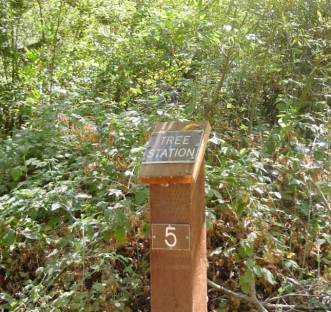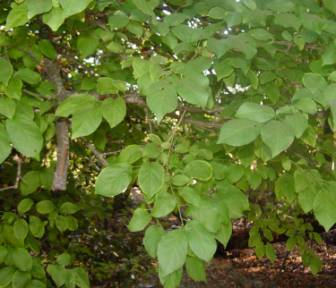STATION 5. TREES
 The
trees in Stivers Lagoon represent a land biome that is referred to as riparian
woodland. Riparian trees require
moisture, deep soil, cooler temperatures, and shade. Muskrat Creek is a permanent, human made stream that
flows through the western part of Stivers Lagoon.
It provides damp, cool
ground that is high in organic matter that nourishes the plant residents of the
nature area.
The
trees in Stivers Lagoon represent a land biome that is referred to as riparian
woodland. Riparian trees require
moisture, deep soil, cooler temperatures, and shade. Muskrat Creek is a permanent, human made stream that
flows through the western part of Stivers Lagoon.
It provides damp, cool
ground that is high in organic matter that nourishes the plant residents of the
nature area.
The three major
trees in Stivers Lagoon are the Red Willow, Fremont Cottonwood, and the
California Black Walnut. Each has
its own characteristic leaves, bark, and overall shape.
Red Willow
(Salix laevigata) is a common tree throughout the lagoon.
There are other willows that you can see at the entrance to Stivers
Lagoon but red willow is mainly found within the nature trail. The leaves are
usually broader near the base with short pointed tips.
The one-year branches are reddish brown.
 Willows
are characteristics of a riparian habitat, which thrive on the moist soil,
cooler temperatures and shade of the other vegetation.
Willows
are characteristics of a riparian habitat, which thrive on the moist soil,
cooler temperatures and shade of the other vegetation.
Fremont
Cottonwood (Populus fremontii)
is the largest of the trees in Stivers Lagoon.
These trees have spade like simple leaves.
Wind rustling
through its leaves makes it sound as if a large river is running through the
area. Cottonwoods range from 12-35
meters in height and trunk diameter ranges from .3 to 1.5 meters.
A young cottonwood has a smooth bark, but as it ages, it has a
characteristic deeply furrowed, whitish bark.
Cottonwoods bloom from March to April with a drooping catkin 4-14 cm
long. The fruit has silky hairs
that resemble cotton, hence the name cottonwood.
 California
Black Walnut
(Juglans californica var. hindsii
is also abundant in the upper part of the riparian zone.
The arrangement and shape of the leaves are characteristic.
The nut is round and dark in color.
California
Black Walnut
(Juglans californica var. hindsii
is also abundant in the upper part of the riparian zone.
The arrangement and shape of the leaves are characteristic.
The nut is round and dark in color.
LESSON. Tree Identification - Ask students to locate the
cottonwood, willow, and walnut trees in this region.
Look at the leaves and bark. Make
sure the students look at the leaf shape, bark (color and texture), arrangement
of branches, and
the overall structure of the trees.
Note:
We do not recommend bark rubbings because of the presence of poison oak.
In this area, poison oak becomes more vine like and tends to grow up the
bark and onto trunks and limbs of trees.
[BACK]
 The
trees in Stivers Lagoon represent a land biome that is referred to as riparian
woodland. Riparian trees require
moisture, deep soil, cooler temperatures, and shade. Muskrat Creek is a permanent, human made stream that
flows through the western part of Stivers Lagoon.
It provides damp, cool
ground that is high in organic matter that nourishes the plant residents of the
nature area.
The
trees in Stivers Lagoon represent a land biome that is referred to as riparian
woodland. Riparian trees require
moisture, deep soil, cooler temperatures, and shade. Muskrat Creek is a permanent, human made stream that
flows through the western part of Stivers Lagoon.
It provides damp, cool
ground that is high in organic matter that nourishes the plant residents of the
nature area. 
